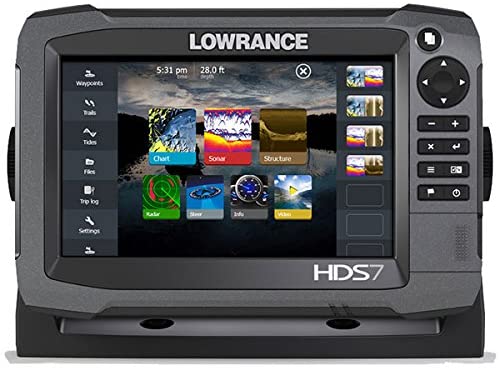Best Fish Finder – Lowrance vs. Humminbird vs. Garmin vs. Simrad
The market of fish finders is truly wide, with many brands pushing their latest models. It can be truly difficult to know which brand to choose since each of them seems so similar at first glance, but they become very different once you start digging and seeing what they offer and what they specialize in.
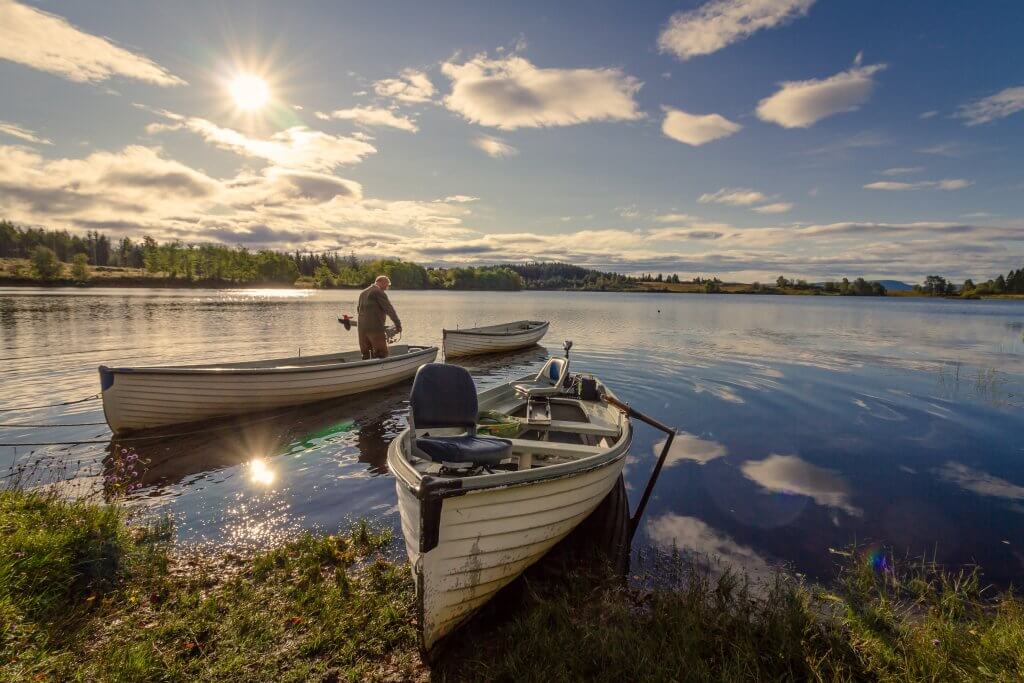
Today we’re looking at the top four brands: Garmin, Lowrance, Humminbird, and Simrad. All four have a history of creating versatile fish finders in a variety of price ranges. Whether you need a high-end, premium unit with half a dozen imaging types, or just something small for the occasional weekend fishing trip, these brands have something for you.
We’ll give you the specifics on each brand and what they offer. Be mindful that we’re only picking the best fish finders in general, so each brand offers more than what we’re displaying here. Have an open mind and we’re certain you’ll find a fish finder that matches your needs and budget.
We’re going broad today and comparing the brands and what they generally offer. Be sure to give each brand a shot and look at everything they offer before making a final choice.

Overview
Before getting too deep into what each brand offers, let’s introduce them to you and get you acquainted. This will give you a better idea of what each brand is and why they offer what they offer.
Lowrance
Lowrance opened its doors in 1957 and has been a leader in marine technology since its inception, creating many fish finders and related sonar units. They have adapted to new trends and imaging techniques, such as side imaging (StructureScan) and down imaging (DownScan) with ease. Perhaps their biggest innovation in the market came in 2008 when they were the first to introduce an HD multifunction screen. They continuously seek and adapt new imaging and technology to their long list of fish finders. From being one of the first to use CHIRP sonars to adding StructureScan and DownScan to their fish finders. Since 2008, they have continued this trend by introducing the first HD multifunction screen along with features such as Trackback to review previous sonar readings, 4G radar connections, and enhanced, picture-like sonar readings.
Humminbird
Humminbird started in 1971 and has been marked by homegrown roots and innovation from start to present. Beginning in a small garage in Alabama, Humminbird started a trend of being the first to produce or use new technology. They were the first to introduce a waterproof depth sounder, one of the first to use LCR screens (which later evolved into modern LCD screens) and they were the first to use 360-degree sonar technology. While their product line has grown to include innovative features like Mega SideImaging, Mega DownImaging, and massive 15-inch HD displays, they haven’t forgotten about their homegrown roots and still develop units for anyone interested in fishing.
Garmin
Garmin has different roots than Lowrance and Humminbird, but their commitment to their fish finders and products, in general, is definitely top class. Starting in 1989, Garmin started and is currently a leader in GPS technologies. They have adapted their GPS units to work with automotive, marine, aviation and outdoor needs, plus they have created many types of wearable tech. Garmin fish finders are among the most advanced and versatile on the market, making them a top contender for best fish finders. They make fewer units in general, but their obsession with quality speaks for itself.
Simrad
Founded in 1946 and known as Simrad Yachting, the company name comes from combining the founder’s last name (Simonsen) with his primary product at the time, radio communication. While Simrad has been purchased by several companies throughout the years, they have never wavered in their mission to create luxury fish finders with sonar, autopilot features, and navigation. Though these are often made for yachts and similar luxury crafts, they make units that everyone can enjoy.
Though each has a different story and emphasis, they all cater to anglers and fisherman by providing them with versatile fish finders that combine GPS, sonar, and other features. They want you to catch as many fish as possible and have fun while doing it. Let’s dive deeper into the brands and see how they match your needs.
Number of Products
The number of products may not seem initially important, but there’s a big reason we’re bringing it up. Having more products means that the brand can reach more markets and hence you’ll have an easier time finding a fish finder that works for your exact needs. It also means that there will be more options and the ability to work within your budget or preferences.
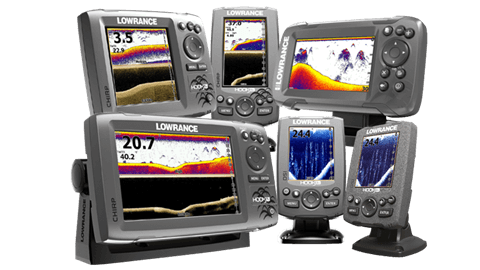
The top two here are definitely Lowrance and Humminbird. Lowrance used to have more, but Humminbird has just slightly edged them out. They have made a variety of fish finders for ice fishing (ICE series), standard models for all anglers (Helix), and premium models with state-of-the-art imaging and updated user interfaces (Solix). They also come in a variety of sizes from 5-15 inches.
Lowrance offers three series with many different sizes and features, ranging from 5-16 inches depending on the model. Hook Reveal is their entry-level series with FishReveal technology and numerous imaging types. The next step up is Elite Ti2, made for serious anglers who want to take their fishing to the next level. Professional and tournament-level anglers should choose the HDS Live series. This has the fastest sonar, the most imaging types, and the clearest displays.
Simrad is quite close. They actually have four types of fish finders, but there tends to be somewhat fewer variety in each series with an overall size of 5-24 inches. Consider them a very close third. The entry-level Cruise series has both a GPS and CHIRP sonar with easy controls. Next is the Go series, which is their best value series. These touchscreen fish finders have numerous imaging types and are easy to install. Next up is NSS Evo3, these are for professionals and powerboat enthusiasts. Lastly is the NSO Evo3, which was made for full luxury cruisers as they offer many imaging types and very large screens.
Garmin is a good brand, but they are a very distant fourth with the smallest number of offerings. They offer the Striker and Striker Plus lines, both of which combine GPS and CHIRP sonar readings into a versatile and handy unit for anglers. There’s also the EchoMAP series with enhanced GPS features and other imaging types. While they don’t have as many units, they are a quality brand with a dedicated following.
Overall Features
At the highest level, all of these brands offer nearly the same features. You can get CHIRP, traditional sonar, down scan, side imaging, multi-panel displays, dedicated GPS units with maps and so on. But, let’s break down what the general offerings are so that you get a better idea of what each brand offers.
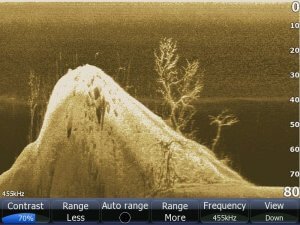
Garmin offers traditional sonar with all their units. The smaller units (4 and 5 inches) have both CHIRP and ClearVu, which is a type of down imaging. The larger 7- and 9-inch models also feature SideVu. The GPS is highly accurate and allows you to draw your own maps. While it relies mostly on waypoints and custom maps, it does a wonderful job of getting you from point A to point B.
Lowrance offers many features and it depends on the series and size of the model. Their smaller units, like the 5-inch ones, offer CHIRP and DownView, while the larger ones also offer SideView. All the Lowrance fish finders offer physical buttons, and the larger ones (around 7-inches or bigger) offer touchscreen capability as well. The more advanced models tend to offer brighter screens, faster GPSs, and stronger imaging for viewing deeper under the water.
Humminbird doesn’t have many products smaller than 5 inches, and the truth is that the majority of their products start at 7 inches and go up from there. While there are a few units only with down imaging, most have side imaging and other advanced features. Their largest model is 15 inches, and you can get WiFi, Ethernet connections and much more. Their maximum depths are amazing, and you can easily make out vegetation, objects and everything else around your boat.
Humminbird offers crystal clear imaging with all their models along with easy controls. Unlike Lowrance, where larger models offered touchscreen, Humminbird makes this more about the series. Helix models only offer physical buttons while Solix has both touch and physical buttons. Many of the models offer both side and down imaging. They have actually been working on the stronger “Max” versions of these, which increases clarity and distance. Regardless of which you get, Humminbird is known for clarity and many imaging types.
Simrad has many features and they tend to separate them based on the series. The Cruise line offers CHIRP imaging, Go offers that along with GPS, down imaging, and structure scan, NSS Evo3 has HD and 3D sonar imaging, and NSO Evo3 has even stronger imaging than the NSS. Some models are touch-only while others only offer physical buttons. Cruise only offers buttons, Go and NSO are touch-only, and NSS offers both. In general, these are high-end fish finders and many imaging types, bright screens, and many features.
Budget-Friendly Options
If money is of no concern to you and you just want the best fish finder possible, then feel free to skip this section. Much like with the overall features section, here we are going to talk about which brand is most budget-friendly so that you get the biggest bang for your buck. Once again, this all depends on which exact model you get.
Lowrance is probably the most evenly priced brand here. While Humminbird now has more models in general, Lowrance offers the most budget-friendly options along with a comparable number of mid-tier and premium models. While you may lose out on some features (like SideScan and a touchscreen), you can find a powerful unit at a good price.
Garmin is also reasonably priced across the board. While they do have some premium offerings, many of their units are easy on the wallet. These are mostly with their smaller units, like the 4- and 5-inch ones, but you can get a great CHIRP sonar for a good price. They tend to offer some of the smallest units, which might be good if portability is an essential feature for you.
Simrad is OK with budget-friendly options. These are really meant for yachts and sportsboats, so their cheapest models aren’t quite as affordable as the other ones. Even their smallest units tend to be more expensive than the mid-sized offerings from other brands. You’re getting great imaging of course, but Simrad isn’t quite as affordable as Lowrance or Garmin.
Humminbird is similar to Simrad. These models are expensive and tend to be the highest here. Depending on the model, it can be a duel between Humminbird and Simrad for the most expensive brand. However, since Humminbird prizes technological innovation and packing in as many features as possible, you can expect their budget-friendly options to have many great features.
Ease of Use
Lastly, let’s talk about ease of use. How quickly can you pick up and learn these fish finders so that you can easily switch between tools and options and start finding fish? Honestly, all three are tied here. They are all built to have low learning curves so that you can immediately get out there and start fishing.
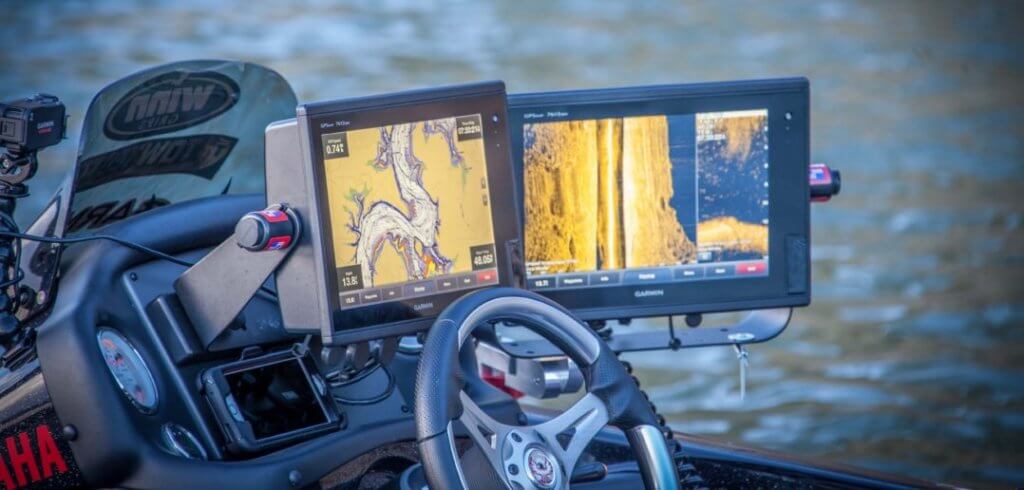
No one wants to spend hours of time reading manuals, figuring out buttons, coordinating options and so on. Each brand knows that fishermen just want to attach the finder to their boat, turn it on and get that sonar running. Don’t worry, you’ll have an easy time regardless of what you choose. Unless you are getting a huge, premium unit, all of the fish finders from these four brands should take very little time to learn and properly use.
Best Models
Here we’ll discuss three of the best models from each brand based on price and functionality. We will separate them into affordable, best value and high-end premium units.
Garmin Line
Affordable: Garmin Striker Plus 4cv
Good things come in small (and affordable) packages. This budget-friendly fish finder has a small 3.5-inch screen with surprisingly good clarity and numerous features. You get CHIRP sonar capabilities for highly detailed images along with ClearVu imaging for downscanning. The depth reaches 830 feet in saltwater and 1,750 feet in freshwater. Fish Symbol technology helps you identify fish when they’re nearby. There are multiple frequencies to choose from for custom imaging.
It has GPS capabilities as well to track where you’re going and how to reach your destination. You can store up to 5,000 waypoints. Quickdraw Contours creates maps of your trails so you can see where you’ve been before. Despite the small display, you can split it into two screens for viewing sonar and GPS simultaneously. Plus, a backlight LED ensures you can see the readings no matter the lighting conditions.
Best Value: Garmin Striker Plus 7sv
The Plus 7sv is the de facto fish finder for serious fishermen. It comes at a great price point and is packed with features along with a large high-resolution 7-inch display. At about $500, you’re getting a premium fish finder for a bargain. The simple interface ensures old pros and newcomers can operate the sonar with ease. You can switch between side imaging, CHIRP sonar, and ClearVU with the push of a button. Or load them all at once. The screen is large enough to see them all simultaneously.
The pinpoint accurate GPS is helpful for navigating and WiFi capabilities allow you to update your map on the fly. The GPS stores 5,000 waypoints at once. The sonar can peer 1,100 feet into saltwater and 2,300 feet into freshwater. If you’re serious about catching fish, then this is the fish finder you want on your boat.
Premium: Garmin EchoMAP UHD 93sv
This is easily one of Garmin’s best fish finders. With a large 9-inch screen and multiple features, this is for fishermen who demand the best on their boat. Along with SideVu and ClearVu, you also get CHIRP imaging and support for some of the best sonars. This comes preloaded with LakeVu G3 maps, which covers over 17,000 lakes to help you find the best fishing spots. If that’s not enough, you can share sonar data with nearby people using ECHOMAP Plus, UHD, and Ultra models.
The 9-inch screen is bright and clear, ensuring you can view the image in any lighting condition. You can load multiple sonar types on the screen at once, and the dedicated buttons on the side ensure you’ll have no problems navigating the fish finder. This premium fish finder has all the features you need along with one of the biggest, clearest displays available. If you want the best, then you just found it.
Lowrance Line
Affordable: Lowrance Hook 4x
You wouldn’t expect a portable 4.3-inch fish finder to have many features, but Lowrance packed as many as they could into this unit. You get traditional sonar, CHIRP, and DownScan. Not enough? What about an optional ice transducer for ice fishing? You also get Advanced Signal Processing. This significantly reduces sonar noise for clearer images. Despite the small screen, you can load multiple imaging types and view them simultaneously.
There are several frequencies to choose from, such as 83, 200, and 455kHz depending on the imaging, and it can scan up to 300 feet deep for DownScan and 1,000 feet with CHIRP. The adjustable backlight makes this easy to view in the morning or night. Sonar images are stored on the SD card and you can check the history for changes or to see if you missed a hiding fish. This is a feature-rich affordable fish finder that’s easy to use for fishermen of all skill levels.
Best Value: Lowrance Elite 5-Ti
Despite its mid-tier price, it’s easy to confuse this for a premium fish finder with its laundry list of features. The Elite line stands as one of Lowrance’s best and the Elite 5-Ti is the most popular in this lineup. Choose from CHIRP, side imaging, down imaging, and more. Need wireless connectivity? You get both WiFi and BlueTooth. This allows you to update maps wirelessly and share data with other Lowrance users. MicroSD card slots allow for expandable memory so you can save more waypoints, custom maps, and trails.
Along with adjustable frequencies and the ability to load multiple imaging simultaneously on the large 5-inch screen, you get Lowrance standard features like Automatic Fish Symbol ID. This ensures you’ll know when a fish is nearby so you can cast your line at the perfect time. For a reasonable price combined with premium features, you can’t go wrong with the Lowrance Elite 5-Ti.
Premium: Lowrance HDS 7 Gen3
The HDS line isn’t just one of Lowrance’s best, it’s one of the top-ranked fish finders in the world. Built with a 7-inch screen that features best-in-class brightness, you get numerous imaging types like DownScan, StructureScan, CHIRP, and more. The multifunction screen is packed with tools, yet even new users can quickly navigate the fish finder with ease. You also get a video input cable, WiFi connectivity, and it can integrate with multiple map programs.
The intuitive GPS can store up to 200 trails and 5,000 waypoints, which is nearly double the number of other fish finders. Need more? You can load two microSD cards up to 32GB each. You’ll love GoFree, a cloud-based feature that lets you download maps from nearby fishermen. Switching between sonar frequencies can be done via the touchscreen or buttons, and depth is about 1,000 feet. For those who want a successful fishing trip, the Lowrance HDS 7 Gen3 is a necessity.
Bonus Premium: Lowrance Elite 9 Ti2
We have another premium offering from Lowrance and they really outdid themselves with this. You get multiple imaging types like CHIRP, downscan, sidescan, and structurescan. This ensures you can view all angles around your boat to find any hiding fish. Speaking of hiding, you also get Active Imaging and FishReveal. Active Imaging combines CHIRP and other scanning types for the clearest imaging possible. FishReveal shows you if fish are hiding near your boat.
As you can expect from a premium fish finder, this has a large 9-inch screen with great resolution and a powerful backlight. You can use either the physical buttons or touchscreen for choosing your preferred imaging type. You get wireless connectivity via BlueTooth and WiFi, plus this can use C-Map Genesis for active mapping in real-time. There’s also expandable memory up to 32GB. If you want the best of the best, then the Lowrance Elite 9 Ti2 might be right for you.
Humminbird Line
Affordable: Humminbird Helix 5 CHIRP DI GPS G2
We’re shoehorning this in since Humminbird doesn’t have many budget-friendly fish finders, so this is both larger and more expensive than the other affordable models here. That being said, you’re still saving money with this surprisingly versatile and powerful 5-inch fish finder. You get CHIRP sonar, down imaging, side imaging, and an accurate GPS for waypoints and chart plotting. The size and form factor is ideal for kayaking, but anyone with a small boat (or large one for that matter) can easily find any fish swimming around them.
The 5-inch screen is vibrant and bright so you can see in any lighting conditions. You also get Humminbird’s SwitchFire tool. This lets you customize the sonar either with Clear mode for better images or Max mode for faster processing and making out large objects. It’s also color-coded based on distance from your vessel. This might be an affordable fish finder, but the large screen and many features make it feel like a mid-tier offering at a discount.
Best Value: Humminbird Helix 7 CHIRP SI GPS G2N
This fish finder is the motherlode of features. The Humminbird Helix 7 has down imaging, side imaging, CHIRP, GPS, dual-beam sonar, chart plotting, and more. Plus, the intuitive interface ensures you can select whichever feature you want with ease. On top of the numerous imaging types, you also get 360-degree view, wireless networking features, and Ethernet access. SmartStrike is a powerful feature that helps predict where the fish are so you know exactly where to cast your line.
The 7-inch screen has fantastic resolution so you can easily see all the imaging types, plus it comes in 256 colors and a bright LED backlight. All this produces one of the clearest and brightest fish finders around. All the buttons are located on the front so you can easily navigate through the features and options. If you want a strong fish finder with tons of features, then the Hummingbird Helix 7 is exactly what you need.
Premium: Humminbird Helix 9 Mega SI GPS G3N
This is very similar to the Helix 7 but with some important changes. The first major change you’ll notice is the 9-inch screen, but that’s far from the only difference. You get all the imaging types of the Helix 7 like the down imaging, side imaging, CHIRP, GPS, dual-beam sonar, and chart plotting. This can also link this to your motor to view engine stats like fuel consumption and performance.
You also get wireless connectivity along with Mega Side Imaging+ and Mega Down Imaging+. The Helix 9 has an improved CPU for faster processing, which you’ll really notice at higher speeds. The 9-inch screen features fantastic resolution and a bright LED backlight for easy viewing regardless of lighting conditions. You’ll find dedicated buttons to the right for changing imaging types or navigating through the other options. This is certainly a premium fish finder worth every penny.
Simrad Line
Affordable: Simrad Go5 XSE
Simrad Go5 XSE is a powerful 5-inch fish finder with many features. It has a best-in-class touchscreen that is responsive, bright, and viewable in every lighting condition. The user interface is simple and you can choose from several imaging types like CHIRP and DownScan. You can also mirror the fish finder on your smartphone or tablet so that you can walk around and still watch the sonar.
The GPS is packed with Insight Maps and C-MAP software, giving you information on over 8,000 lakes and rivers in the US. You can store thousands of waypoints with a 32GB memory card, and the GPS is one of the fastest you’ll find anywhere.
It might be small, but this is a powerhouse packed with features. If you want to try an affordable Simrad fish finder, then this is the best place to start. You get most of the Go features at a great price.
Best Value: Simrad Go7 XSE
Looking for a bigger screen and even more power? Then give the Simrad Go7 XSE a try. The large 7-inch screen makes it perfect for nearly any vessel, and it’s bright enough to work in any lighting condition. You get the intuitive Simrad user interface, with large digital buttons and easy controls. Along with CHIRP and DownScan, you’re also getting SideScan, ForwardScan and radar compatibility.
Feel free to mirror this fish finder to your smartphone or tablet so that you can control it while walking around the boat. You also get a powerful GPS that’s one of the fastest around, along with Insight Maps and C-MAP software. A memory card allows you to store up to 10,000 waypoints with ease.
This is one of the best values you can get with Simrad. It’s a strong fish finder with lots of features and a great display. It’s worth every penny and will make your fishing trip all the more exciting.
Premium: Simrad Go9 XSE
If money is no object and you have a big vessel or want a fish finder as your center console, then the Go9 XSE was made for you. The massive 9-inch display is bright, clear, and viewable in all lighting conditions. Whether the sun is rising, directly overhead, or it’s pitch black, you’ll see the sonar readings and GPS without any problems. You get the same Simrad user interface along with the ability to load four views at once, and at this size none of them will look cramped.
You can mirror the fish finder to your device, and you also get intuitive map programs like C-MAP and Insight Maps. Unlike the other two models, this one takes two memory cards and can save up to 20,000 waypoints, which is ideal for anyone with an adventuring spirit. You’ll have no problem navigating any waters.
If you absolutely need the best, then Simrad Go9 XSE is right for you.
Fish Finder Features to Look Out For
We’ve just compared three top brands and many of their best models, but you might still have a hard time knowing which fish finder is right for you. This fish finder buyer’s guide will break down the most important features so that you know what to look for.
Screen Size
Bigger isn’t always better when it comes to fish finder screen size. While larger screens allow you to see more and the image is often clearer, this also makes the entire model larger. If you’re in a kayak or smaller vessel, then a larger model might not be right for you. The screen sizes usually range from 3 to 9 inches (or larger). Also be sure to check the resolution to ensure the image is clear.
Transducer
Transducers are essential to receiving sonar waves and seeing what’s under the water. You won’t be able to use your fish finder without one. Some models come with a transducer already (like many of the Garmin fish finders). Some might also work with special transducers, like ones for ice fishing.
Frequency
The majority of fish finders give you at least three frequencies to choose from. Each one gives you a different depth and image clarity. You should consider both the number of frequencies (more is always better than fewer) and which ones suit your needs the best. A lower frequency scans deeper into the water, but the image isn’t quite as clear. Higher frequencies have a smaller cone, but the image looks better.
For example, 80KHz can peer deep into the water while 400KHz will show you fish closer to the surface.
Maps and GPS
Be sure to check the map software to see how many maps are built into the fish finder. Some come with thousands of maps while others require that you buy additional map software. There are also some that don’t come with maps at all. You should also consider how accurate the GPS is and if one is included with the hardware. Some don’t have a GPS, but they can still find fish just fine. If you want to use this for navigating, then get a model with both map software and a GPS.
Water Type
While a fish finder should technically work with any water type, some are specialized or made to work better with certain types of water. The main three you should consider are fresh water, salt water, and ice fishing. Consider where you normally fish and see how well the fish finder works with that water type.
Scanning
As you may have noticed during our fish finder review, there are several scanning types to choose from. While each brand chooses their own names for these, they often come in side scan, down scan, CHIRP, and more. This allows you to choose the direction of the scan. For example, side scanning allows you to see around the sides of your boat while down scan looks under the boat. It’s best to choose a model with all the scanning types, but if you have to choose one or two, then consider which ones you’ll use most often.
Max Depth
The last thing to consider is max depth. How far does the fish finder scan? Plus, you want to ensure that the image is clear so that you can see how many fish are around you. There’s no point in scanning thousands of feet down if you can’t see the fish around your boat. Make sure that it reaches your target fish and has a little extra room if you need it.
Conclusion
The best fish finder requires that you consider all the different aspects. You have to consider size, price, features, image types, and controls. While there are many things to consider, the good news is that it’s easy to find models that cater to your exact needs, especially between these four brands. Each excels in a different area, and it shouldn’t be hard finding one that works for you.
Just consider what’s most important for your fishing journey and you’ll find the best fish finder for your needs.







